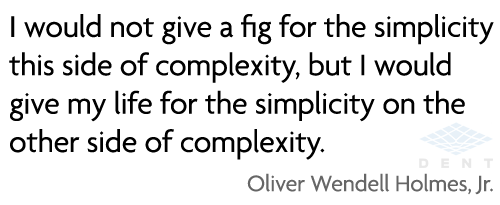Repeating the obvious
 Truly great visionaries have mastery over their domains. They have spent the time and the effort to find the simplicity on the other side of complexity in the problem they are working to solve, and they have the ability to share that now-simplified understanding with everyone else.Getting this right is really hard. One of the big challenges is that once you've spent the time mastering the topic yourself, you suffer from the curse of knowledge, and find yourself repeating the obvious ad infinitum.It is surprisingly difficult to imagine that what is obvious to you is not necessarily obvious to everyone else. During a presentation I gave recently, I added a quick verbal tick before a story I had included in the talk: "you've probably all heard this one before," -- and afterwards, several folks told me the story was entirely new to them.It can be annoying, when you know something well, to have someone present an "obvious" aspect of it to you as though it were new and exciting. So it's easy to say "I'm not going to do that. I'm not going to be that speaker." And then you forget to include the obvious, or you include it with no enthusiasm, and it deadens your vision.Many public advocates, CEOs, politicians, and others who cause change work to effect it through years or decades of effort. In this kind of work, the advocate must always speak to the level of culture in general. That's a lot of repeating the obvious. It's harder than it seems -- but it is also an opportunity to refine your craft.John Maeda, designer and technologist, has written a book called The Laws of Simplicity, and in it he shares his experience of this realization:
Truly great visionaries have mastery over their domains. They have spent the time and the effort to find the simplicity on the other side of complexity in the problem they are working to solve, and they have the ability to share that now-simplified understanding with everyone else.Getting this right is really hard. One of the big challenges is that once you've spent the time mastering the topic yourself, you suffer from the curse of knowledge, and find yourself repeating the obvious ad infinitum.It is surprisingly difficult to imagine that what is obvious to you is not necessarily obvious to everyone else. During a presentation I gave recently, I added a quick verbal tick before a story I had included in the talk: "you've probably all heard this one before," -- and afterwards, several folks told me the story was entirely new to them.It can be annoying, when you know something well, to have someone present an "obvious" aspect of it to you as though it were new and exciting. So it's easy to say "I'm not going to do that. I'm not going to be that speaker." And then you forget to include the obvious, or you include it with no enthusiasm, and it deadens your vision.Many public advocates, CEOs, politicians, and others who cause change work to effect it through years or decades of effort. In this kind of work, the advocate must always speak to the level of culture in general. That's a lot of repeating the obvious. It's harder than it seems -- but it is also an opportunity to refine your craft.John Maeda, designer and technologist, has written a book called The Laws of Simplicity, and in it he shares his experience of this realization:
A few years ago, I visited the master of Swiss typographic design, Wolfgang Weingart, in Maine to give a lecture for his then regular summer course. I marveled at Weingart’s ability to give the exact same introductory lecture each year. I thought to myself, “Doesn’t he get bored?” Saying the same thing over and over had no value in my mind, and I honestly began to think less of the Master. Yet it was upon maybe the third visit that I realized how although Weingart was saying the exact same thing, he was saying it simpler each time he said it.Through focusing on the basics of basics, he was able to reduce everything that he knew to the concentrated essence of what he wished to convey. His unique example rekindled my excitement for teaching.
All of the great masters of communication do this. Steve Jobs makes a good example because there's so much video of him available on YouTube. Here's an example of Steve explaining computers through an analogy, in 1980:Then a decade later, he tells the same story in this interview (it answers the first question -- starts about a minute in). Note that he gets halfway through it, and then asks to do it again a little better:
